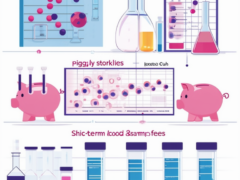
Evaluating the Cost-Benefit Analysis of Additional Services in Cord Blood Banking
Optimizing Cord Blood Banking Services: A Comprehensive Cost-Benefit Analysis
Cord blood banking has become an increasingly popular option for expectant parents, offering a valuable source of stem cells that can be used for future medical treatments. As the industry has grown, many banks have begun to offer additional services beyond basic storage, such as extended storage periods, sibling cord blood banking, and even advanced processing techniques. While these added services can provide additional benefits, it’s crucial for parents to carefully evaluate the cost-benefit analysis to ensure they’re making the best decision for their family.
Evaluating the Cost of Additional Cord Blood Banking Services
One of the primary factors to consider when assessing the cost-benefit of additional cord blood banking services is the financial impact. The base cost of cord blood banking can vary widely, ranging from a few hundred dollars to several thousand, depending on the bank and the specific services included. When considering additional services, parents must carefully weigh the added expenses against the potential benefits.
Extended storage periods, for example, can provide peace of mind and a longer window for potential future use, but they come with an ongoing annual fee. Similarly, sibling cord blood banking offers the opportunity to store cells for multiple children, but the initial investment is typically higher. Advanced processing techniques, such as red blood cell reduction or plasma depletion, may also come with an added cost, though they can potentially improve the quality and usability of the stored sample.
Assessing the Potential Benefits of Enhanced Cord Blood Banking Services
While the cost of additional cord blood banking services is an important consideration, it’s equally crucial to evaluate the potential benefits. Extended storage periods, for instance, can ensure that the stored cells remain viable and accessible for many years, potentially increasing the likelihood of future use. Sibling cord blood banking, on the other hand, can provide a backup source of cells for multiple children, offering a safeguard in case one child’s sample is ever needed.
Advanced processing techniques, such as red blood cell reduction or plasma depletion, can also enhance the quality and potency of the stored stem cells, potentially improving their effectiveness in future medical treatments. In some cases, these advanced services may even be required by certain medical facilities or treatments, making them a necessary investment.
Balancing Costs and Benefits: A Personalized Approach
Ultimately, the decision to invest in additional cord blood banking services is a highly personal one, and parents must carefully evaluate their own needs, budget, and long-term goals. By thoroughly assessing the cost-benefit analysis, parents can make an informed decision that aligns with their family’s unique circumstances and priorities.
In some cases, the added expense of enhanced services may be well worth the peace of mind and potential medical benefits. In others, the basic cord blood banking package may be sufficient, and the additional costs may not justify the marginal benefits. By carefully weighing the pros and cons, parents can ensure that they make the best choice for their family’s needs and financial situation.
As the cord blood banking industry continues to evolve, it’s essential for parents to stay informed and proactive in their decision-making process. By understanding the cost-benefit analysis of additional services, they can make an informed choice that balances their financial constraints with the potential medical benefits for their family. By prioritizing their needs, evaluating the available options, and seeking guidance from medical professionals, parents can navigate the complexities of cord blood banking and ensure that they make the best possible decision for their loved ones.
Potential Advantages of Expanded Cord Blood Bank Offerings
The Potential Advantages of Expanded Cord Blood Bank Offerings
As the field of cord blood banking continues to evolve, many parents are exploring the potential benefits of expanding their services beyond the basic storage of cord blood. Cord blood banks now offer a range of additional services, each with its own set of advantages and considerations. In this article, we’ll delve into the cost-benefit analysis of these expanded offerings, helping you make an informed decision about the best options for your family.
Expanded Stem Cell Storage
One of the primary expanded services offered by cord blood banks is the storage of additional stem cell sources, such as cord tissue and placental tissue. These tissues are rich in mesenchymal stem cells, which have shown promise in regenerative medicine and potential applications for various medical conditions.
The cost-benefit analysis of this service lies in the potential future medical benefits. While the initial investment in storing these additional stem cell sources may be higher, the long-term value comes from the increased likelihood of finding a suitable match for future treatments or therapies. This can provide peace of mind and a sense of security for families, knowing that they have a broader range of stem cell options available if needed.
Personalized Genetic Screening
Cord blood banks are now offering personalized genetic screening services, which can provide valuable insights into an individual’s genetic makeup and potential health risks. This information can be used to develop targeted preventative healthcare strategies and guide future medical decisions.
The cost-benefit analysis of this service involves weighing the initial cost of the genetic screening against the potential benefits of early intervention, risk mitigation, and personalized healthcare. While the upfront cost may be higher, the long-term value of having a comprehensive understanding of one’s genetic profile can be invaluable in maintaining optimal health and well-being.
Extended Storage Periods
Traditionally, cord blood was stored for a limited timeframe, typically around 20-25 years. However, some cord blood banks now offer extended storage periods, allowing parents to maintain access to their child’s cord blood for a more extended duration.
The cost-benefit analysis of this service centers around the likelihood of the cord blood being needed in the future. While longer storage periods incur higher fees, the potential benefit lies in the increased chances of the cord blood being a suitable match for future medical treatments, either for the child or other family members. This can be particularly valuable for families with a history of genetic or medical conditions.
Sibling Cord Blood Storage
Some cord blood banks provide the option to store cord blood from multiple children within the same family. This can be beneficial in situations where a sibling may require a stem cell transplant, and a matching donor is needed.
The cost-benefit analysis of this service revolves around the potential need for a sibling stem cell match. While the upfront cost of storing multiple cord blood units may be higher, the peace of mind and increased likelihood of finding a suitable match can be invaluable in the event of a medical emergency. This service can be especially valuable for families with a history of genetic or medical conditions that may require stem cell therapies.
Comprehensive Cord Blood Banking Solutions
Cord blood banks are now offering comprehensive solutions that integrate multiple services, such as expanded stem cell storage, genetic screening, and extended storage periods. This bundled approach can provide a more holistic and cost-effective solution for families.
The cost-benefit analysis of a comprehensive cord blood banking solution involves considering the overall value and potential synergies between the various services. While the initial investment may be higher, the combined benefits of these expanded offerings can offer greater long-term value, particularly for families with a higher likelihood of needing access to a broader range of stem cell sources and genetic information.
The potential advantages of expanded cord blood bank offerings are multifaceted and can provide significant benefits to families. By carefully evaluating the cost-benefit analysis of each service, parents can make an informed decision about the best options to meet their family’s unique needs and preferences.
Challenges in Determining the Value of Supplementary Cord Blood Services
Evaluating the Cost-Benefit Analysis of Supplementary Cord Blood Services
Cord blood banking has become an increasingly popular option for expectant parents, offering the potential to preserve valuable stem cells for future medical use. However, in addition to the core cord blood banking services, many providers now offer supplementary services that come with an additional cost. Evaluating the cost-benefit of these supplementary offerings is crucial for parents to make an informed decision.
Understanding Supplementary Cord Blood Services
Supplementary cord blood services can include a wide range of offerings, such as extended storage periods, additional testing, and specialized processing techniques. These services are often marketed as enhancing the value and potential of the stored cord blood, but their actual benefits can be difficult to quantify.
Assessing the Potential Benefits
One of the key considerations when evaluating supplementary cord blood services is the potential medical benefits they may provide. While extended storage periods can indeed extend the usable lifespan of the stored cells, the likelihood of needing to access those cells decades in the future is relatively low. Similarly, additional testing and specialized processing may offer marginal improvements in stem cell quality, but the clinical significance of these differences is often unclear.
Considering the Financial Impact
The cost of supplementary cord blood services can be significant, often adding hundreds or even thousands of dollars to the overall price tag. Parents must carefully weigh the potential benefits against the financial burden, especially in light of the uncertainty surrounding the future need for the stored cells.
Prioritizing Necessary Services
In many cases, the core cord blood banking services, including collection, processing, and initial storage, may be sufficient to meet the needs of most families. By focusing on these essential services, parents can potentially save a considerable amount of money without sacrificing the core value of cord blood banking.
Seeking Objective Guidance
Given the complex nature of evaluating supplementary cord blood services, it is often helpful for parents to seek guidance from medical professionals, financial advisors, or independent cord blood banking experts. These individuals can provide an objective analysis of the true costs and benefits, helping parents make an informed decision that aligns with their specific needs and budget.
Staying Informed and Flexible
As the cord blood banking industry continues to evolve, it is important for parents to stay informed about the latest developments and to remain flexible in their decision-making. Ongoing research and technological advancements may change the landscape of supplementary services, potentially altering the cost-benefit analysis over time.
The evaluation of supplementary cord blood services requires a careful consideration of the potential benefits, the financial impact, and the individual needs of the family. By prioritizing essential services, seeking objective guidance, and staying informed, parents can make a well-informed decision that best serves their long-term interests and the health of their child.
Assessing the Long-Term Financial Impact of Cord Blood Banking Upgrades
Financial Implications of Cord Blood Banking Upgrades
As the demand for personalized healthcare solutions continues to grow, the cord blood banking industry has experienced a significant surge in popularity. Families are increasingly recognizing the potential benefits of preserving their child’s stem cells, which can be used in the future for various medical treatments. However, the decision to invest in cord blood banking services is not without its financial considerations. In this article, we will explore the long-term financial impact of upgrading cord blood banking services.
Evaluating the Costs of Cord Blood Banking Upgrades
When it comes to cord blood banking, families are often faced with a range of options, each with its own set of costs and features. Upgrading to a more comprehensive service can provide additional benefits, such as extended storage periods, advanced processing techniques, or the ability to store multiple samples. However, these upgrades come with a corresponding increase in the overall cost of the service.
It’s essential to carefully examine the cost-benefit analysis of these upgrades to determine whether the additional investment is justified. Factors to consider include the likelihood of the stored samples being needed in the future, the potential medical benefits of the upgraded services, and the family’s overall financial situation.
Assessing the Long-Term Financial Implications
The decision to upgrade cord blood banking services can have significant long-term financial implications for families. The initial cost of the upgrade, which can range from hundreds to thousands of dollars, must be weighed against the potential future benefits.
One of the key considerations is the lifespan of the stored samples. Cord blood can be stored for decades, and the longer the samples are preserved, the more valuable they become. Upgrading to a service that offers extended storage periods can provide peace of mind and ensure that the investment remains viable for the long term.
Additionally, the potential medical benefits of the upgraded services must be factored into the equation. If the advanced processing techniques or expanded storage options provided by the upgraded service increase the chances of successful medical treatments, the long-term financial impact could be substantial, potentially offsetting the initial investment.
Balancing Cost and Value
Ultimately, the decision to upgrade cord blood banking services is a personal one that requires careful consideration of the family’s financial situation, the potential medical benefits, and the long-term implications. It’s essential to weigh the costs against the perceived value to ensure that the investment aligns with the family’s priorities and budgetary constraints.
One approach to this decision-making process is to consult with financial advisors or medical professionals who can provide expert guidance. They can help families understand the nuances of cord blood banking, the various upgrade options, and the potential financial and medical implications of each choice.
By carefully evaluating the cost-benefit analysis of cord blood banking upgrades, families can make an informed decision that balances their financial well-being with the potential to safeguard their child’s future health.
Striking the Right Balance Between Cost and Comprehensive Cord Blood Services
The Cost-Benefit Equation: Evaluating Comprehensive Cord Blood Services
Cord blood banking is a significant decision for families, with both financial and medical implications. As parents weigh the benefits of storing their child’s cord blood, they must also consider the cost associated with the various services offered by cord blood banks. Striking the right balance between comprehensive offerings and cost-effectiveness is crucial to ensuring families can access the full potential of cord blood banking.
Assessing the Value of Comprehensive Cord Blood Services
Cord blood is a rich source of hematopoietic stem cells, which have the potential to treat a wide range of medical conditions, from blood disorders to certain types of cancer. Comprehensive cord blood banking services often include features like:
- Long-term cryogenic storage to preserve the integrity of the sample
- Genetic testing and screening to identify potential health risks
- Ongoing sample maintenance and quality assurance
- Access to the bank’s inventory for potential future use
These services can provide families with the peace of mind that their child’s cord blood is stored safely and can be accessed if needed. However, the cost of these comprehensive offerings can be a significant factor in the decision-making process.
Balancing Cost and Coverage
Cord blood banking fees can vary widely, depending on the services included and the provider. Basic storage packages may start at a few hundred dollars, while more comprehensive options can cost several thousand. Families must weigh the potential benefits of the additional services against the financial impact.
For some families, the cost of comprehensive cord blood banking may be prohibitive. In these cases, they may opt for a more streamlined, low-cost option that still provides basic storage and access to the sample. While this may limit the potential medical applications, it can still offer valuable protection for the child’s cord blood.
Maximizing the Potential of Cord Blood Banking
To strike the right balance, families should carefully research the various cord blood banking providers and understand the specific services included in each package. They should also consider their family’s medical history and the potential need for cord blood in the future.
In some cases, families may be able to take advantage of financial assistance programs or payment plans offered by cord blood banks. This can help make the more comprehensive services more accessible and ensure that families can access the full potential of cord blood banking.
Staying Informed and Proactive
As the field of cord blood banking continues to evolve, it’s essential for families to stay informed about the latest developments and options available. Regular communication with the cord blood bank, as well as discussions with healthcare providers, can help families make informed decisions about the level of coverage they need.
By carefully evaluating the cost-benefit analysis of comprehensive cord blood services, families can make a decision that aligns with their financial situation and medical needs, ensuring that they can take full advantage of the remarkable potential of cord blood banking.
Key Takeaway
The decision to offer additional services in cord blood banking is a complex one that requires a careful cost-benefit analysis. On one hand, expanding the range of services can provide potential advantages, such as increased customer satisfaction, enhanced medical capabilities, and the opportunity to stay competitive in a rapidly evolving industry. However, the challenges in determining the true value of supplementary cord blood services and assessing their long-term financial impact must be thoroughly evaluated.
Evaluating the Cost-Benefit Analysis of Additional Services in Cord Blood Banking
Cord blood banking is a crucial aspect of modern healthcare, providing families with the option to preserve potentially life-saving stem cells for future use. As the industry continues to evolve, cord blood banks are faced with the decision of whether to offer additional services beyond the basic storage and preservation of cord blood.Potential Advantages of Expanded Cord Blood Bank Offerings
Expanding the range of services provided by a cord blood bank can bring several potential benefits. Offering advanced testing, processing, and storage options may enhance the medical capabilities and value proposition of the bank, attracting a wider customer base and increasing satisfaction among existing clients. Additionally, staying ahead of the competition by introducing new services can be a strategic move to maintain a leading position in the industry.Challenges in Determining the Value of Supplementary Cord Blood Services
Determining the true value of supplementary cord blood services, however, can be a complex and challenging task. The benefits of these additional offerings may not always be immediately apparent, and quantifying their long-term impact on patient outcomes and the financial sustainability of the cord blood bank can be difficult. Factors such as customer preferences, market trends, and the potential for technological advancements can further complicate the cost-benefit analysis.Assessing the Long-Term Financial Impact of Cord Blood Banking Upgrades
Evaluating the long-term financial impact of introducing new cord blood banking services is crucial. The upfront costs associated with implementing and maintaining these services, as well as the potential for changes in customer demand and pricing, must be carefully considered. Understanding the break-even point and the timeline for recovering the initial investment is essential to ensure the financial viability of the expanded offerings.Striking the Right Balance Between Cost and Comprehensive Cord Blood Services
Ultimately, cord blood banks must strike a delicate balance between providing a comprehensive range of services and maintaining affordable pricing for their clients. Offering a broad portfolio of options may appeal to a wider customer base, but it must be balanced against the costs and the potential impact on the bank’s financial sustainability. Careful planning, market research, and ongoing monitoring are essential to ensure that the expansion of cord blood banking services delivers tangible benefits to both the organization and its clients.
Conclusion
As the cord blood banking industry continues to evolve, evaluating the cost-benefit analysis of additional services has become a crucial consideration for both providers and consumers. The potential advantages of expanded cord blood bank offerings, such as increased storage options, enhanced testing capabilities, and personalized genetic analysis, can offer compelling value propositions. However, the challenges in determining the true long-term value of these supplementary services require careful analysis and consideration.
One of the primary factors to weigh is the long-term financial impact of implementing these cord blood banking upgrades. While the initial investment may be significant, the potential benefits to customers in terms of improved health outcomes and peace of mind could justify the added expense. Providers must carefully assess the projected demand for these services, the potential revenue streams, and the overall impact on the financial viability of the organization.
Another critical aspect to consider is striking the right balance between cost and comprehensive cord blood services. Customers are increasingly seeking more advanced and personalized options, but they are also sensitive to the pricing of these services. Providers must find a way to offer a robust suite of services without pricing them out of reach of the average consumer. This delicate balance requires in-depth market research, customer feedback, and a deep understanding of the target audience’s needs and preferences.
One potential solution to this challenge is the implementation of tiered service offerings, allowing customers to select the level of services that best fits their budget and requirements. This approach can provide a more accessible entry point for those seeking basic cord blood banking, while still offering advanced options for those willing to invest in more comprehensive services. By catering to a diverse range of customer needs and budgets, providers can optimize their offerings and maximize the perceived value for their clients.
Furthermore, the evaluation of cost-benefit analysis must extend beyond the immediate financial considerations and consider the broader societal and public health implications of expanded cord blood banking services. Access to advanced genetic testing and personalized medicine can have far-reaching benefits, potentially leading to earlier disease detection, more targeted treatments, and improved overall health outcomes. Providers must weigh these long-term, population-level benefits against the short-term cost considerations.
The evaluation of the cost-benefit analysis of additional services in cord blood banking is a complex and multifaceted endeavor. Providers must carefully consider the potential advantages, the challenges in quantifying value, the long-term financial impact, and the balance between cost and comprehensive services. By adopting a strategic and data-driven approach, cord blood banking organizations can navigate this evolving landscape and provide their customers with the most valuable and accessible services possible. As the industry continues to advance, this cost-benefit analysis will remain a critical factor in shaping the future of cord blood banking and its role in personalized healthcare.



















